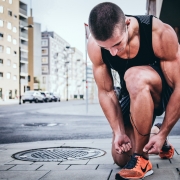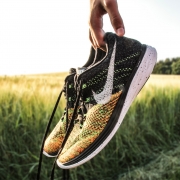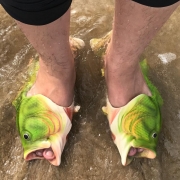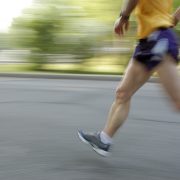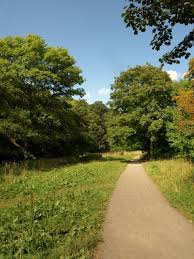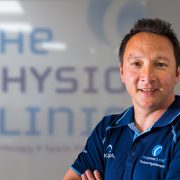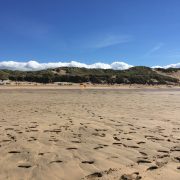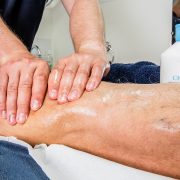Some simple rules from a physiotherapist in helping you get the right pair of trainers
/in Uncategorised/by Pete TangToe box, heel cup, heel lift, cushioning, support
Look at your feet – an aerial view of the shape of your trainer should be a similar shape to your foot. – If you have a wide foot you will need a wide trainer and/or a wide foot box (bit where your toes go). If you have a narrow heel you will need a suitable heel cup to ensure your rear foot does not slide around.
Pronation is a normal part of gait that is both necessary and important. Your foot shape and skeletal structure will play a role in determining the posture and mechanics of your foot. Just because someone tells you that you have flat feet or that you pronate, do not be scared into trusting they know what trainers will suit you.
If you have limited ankle range of movement, have super tight calves, or spend a lot of your day in heels then you are likely to need some heel drop, going to a totally flat sole may cause you issues.
Does your trainer meet the needs of the demand of the type of running you intend to do?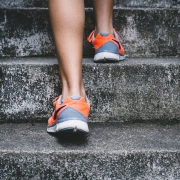
Does it fit properly and is it comfortable to wear? It should be totally comfortable right from the start.
Buying a shoe that fits and is comfortable and is specifically suited to your sport and body type is the most important thing.
Buy trainers which you find comfortable and designed to meet the needs of your event/body size. If you run sprints on track then buy light, spike designed shoes; if you run marathons spend the money on marathon shoes which have cushioned soles for running longer distances; if you are heavy set then buy something with lots of cushioning to try and help protect you joints. Whatever you buy…break them in gradually.
Summer is coming – The pro’s & cons of flip-flops
/in Uncategorised/by Pete TangFlip-flops and slip on shoes in general (for the purpose of this article we will just call them all flip-flops) are great for being easy to get on and off quickly and for keeping cool and showing off your feet when you’re wearing shorts.
Unfortunately, that is all they are good for!
They have a place in your wardrobe for wearing in public showers/changing rooms and on the patio when having a BBQ, and that is about as far as you should travel in them.
Flip-flops change the action of how you use your foot when walking. This is due to the foot having to grip to keep the shoe from falling off. They also trick your feet into thinking you have footwear on and then provide little to no support for your foot. This extra work will cause fatigue in your feet and calves and may even lead to overuse injuries. In the short term the acute increase in stress on your feet can cause pain and inflammation in the soft tissues of your feet, ankles and calves. With prolonged use flip-flops can cause chronic shortening of these tissues leading to a change in the way you move; this in turn creates continued overload of some very important structures in your lower legs.
The growing market for ‘good for you flip-flops’ (such as Birkenstock and Fitflops etc) do help a little on the support side, but ultimately they are still a slip on shoe and will affect your foot mechanics. You are still increasing the load on your lower leg and changing the way you walk due to your footwear.
Some common conditions we see regularly in clinic due to flip-flop use include: plantar fasciitis, tibialis posterior tendinopathy, Achilles tendinopathy, tight calves, heel bursitis and reduced big toe mobility – which is a mechanical nightmare for numerous reasons. There is no guarantee that you will suffer with these conditions if you spend your summer in flip-flops, but you are significantly increasing your chances. Pain can be a very late symptom in a lot of these cases and the soft tissue changes can go undetected for months or years before they become a problem.
In conclusion: If there is any risk of you walking more than 100m total that day in your flip-flops – choose different footwear!
For those that are not that into reading – here is a video that sums this up: https://www.mobilitywod.com/propreview/athletes-dont-wear-flip-flops-episode-219/
Adverse Weather Feb 1st and 2nd 2019
/in Uncategorised/by Pete TangPlease note that the clinic will be closing early at 13:30 on Friday 1st Feb. We will be open as normal from 8:00am on Saturday 2nd Feb.
Top 5 Bristol Walks
/in Uncategorised/by Pete TangThe weather this week is looking glorious, so we thought we would share 5 walks around the Bristol area that will help you with achieving the 10,000 steps a day goal. This may sound like a lot but you can easily do it without realising. Whether it’s through walking or something else you enjoy, it is very much possible and hopefully these walks will help with that.
Blaise Castle Estate
Blaise Castle Estate, has many different trail walks to keep you moving whilst you admire the gorgeous surroundings. The shortest walk is 1.25 miles called the Castle Walk where you get to see the gorge and woodlands.

The longest walk is called the Rhododendron Walk which is a 3 mile trail where you get to see the historic buildings on site.
Alternatively, you could do your own walk where you explore all that the Estate has to offer, including the Blaise Castle House Museum and the huge play area. It’s perfect for getting the whole family active as there are masses of playing fields to play football, rugby or whatever sport you like. It is also all free so take a picnic and have a fun day out in the sun!
Leigh Woods
Another fabulous walk is Leigh Woods, which is a National Trust woodland, overlooking the Clifton Suspension Bridge and Avon Gorge. It’s the lovely walk to get away from busy city life and to take in all that nature has to offer.
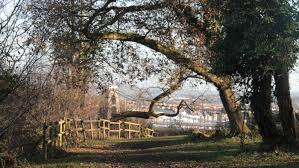
It has a picnic area full of bespoke benches and carved wooden sofas to make the place welcoming and interesting to all. Dogs are welcome so why not take your 4 legged friend exploring with you? Just make sure you keep them safe and away from the cows, that are there to help the conservation of the woods in the spring and summer months.
Bristol Harbourside
Why not take a stroll around Bristol’s famous harbourside and enjoy the views that it offers. From the rainbow houses to the iconic ships, there’s something for everyone.
 Take a break in one of the many eateries that overlooks the River Avon to soak up the sights. Come rain or shine there is always something to see and do to keep you entertained, including a market on Sundays at the Watershed where you can see masses of homemade goodies. Whilst at the Harbourside, you can visit the SS Great Britain which is a big part of Bristol’s identity. You could even take part in one of the many activities that Bristol offers on the river. No matter what you like doing, you’ll have a great view to enjoy it with.
Take a break in one of the many eateries that overlooks the River Avon to soak up the sights. Come rain or shine there is always something to see and do to keep you entertained, including a market on Sundays at the Watershed where you can see masses of homemade goodies. Whilst at the Harbourside, you can visit the SS Great Britain which is a big part of Bristol’s identity. You could even take part in one of the many activities that Bristol offers on the river. No matter what you like doing, you’ll have a great view to enjoy it with.
Clifton Downs
Bristol is known for its beautiful Downs that hold many events throughout the year. It is a large green space that is free to use and has plenty of views of the Clifton Suspension Bridge and the Avon Gorge. 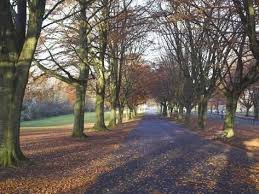 There are many different walks that are recommended by the Bristol City Council website, if you are interested in looking at specific wildlife. Or take your time and just soak up the weather on your day out.The Downs are perfect for children, as there is plenty of space for them to play, as well as the ice cream vans that frequent the area. If ice cream isn’t your thing, then why not stop off at the cafe to re-fuel?
There are many different walks that are recommended by the Bristol City Council website, if you are interested in looking at specific wildlife. Or take your time and just soak up the weather on your day out.The Downs are perfect for children, as there is plenty of space for them to play, as well as the ice cream vans that frequent the area. If ice cream isn’t your thing, then why not stop off at the cafe to re-fuel?
This walkway follows the River Frome that runs from Old Sodbury all the way to St Pauls Roundabout in Bristol. You can just walk this route or take one of the many paths that lead off from the walkway. It is a very picturesque walk filled with open meadows and wooded forests. It follows the culture of South Glos with information online about the different areas and what they were known for. You can do as little or as much of the walk as you like, take your time and take in all that the area has to offer. There are plenty of pubs and cafe for you to stop at on the way so you can relax and enjoy your day out. Guides for these walks can be found online so it’s easy for you to access!
19.03.18 We Are Open
/in Uncategorised/by Pete TangMorning All,
We are open as usually today.
Station Road is very slippy, so please drive carefully and allow extra travel time for you appointment.
Pete & The Clinic Team

Open as normal
23rd Jan 2018 Power outage
/in Uncategorised/by Pete TangALERT
Please note that there is a power outage affecting the clinic, leisure club and surrounding area. Power should be restored by 1:00 pm. During this time our phone systems will be out of action. If you need to contact us please do so by email as we can still access this remotely. Sorry for any inconvenience.
The Physio Clinic
10 Years On, Going Strong and Why I’m Sorry!!
/in Uncategorised/by Pete Tang
I first opened the door of The Physio Clinic in May 2007. Just me. It was a big decision. I say ‘just me’ but I had the support of family and friends and most importantly, Tracy, my wife. I’d been working very successfully as a private physiotherapist for several years for BUPA hospitals, The Jonathan Webb Clinic and at other private practices. I’d taken the bold step to set up my own clinic! Why? To deliver my vision of what physiotherapy should be – that understanding and treating the cause of the problem and educating people, not just helping with pain, was fundamental to my success in helping my patients achieve their goals.
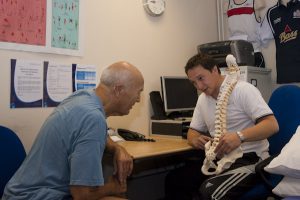
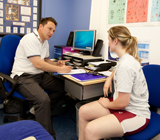
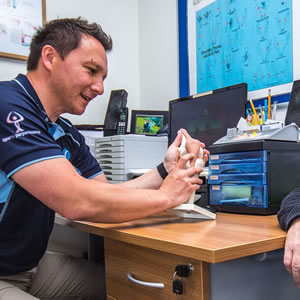
It had taken several months of planning and hundreds of hours of thought and decision making from what to call the company, to what type of paper to use for the letterhead. Decisions, decisions, decisions…. I’d like to make special thanks to Lisa from ‘Drawn 2 Design’ for helping with the company image and brand and Wayne from ‘Tooze IT’ (now Blaze Concepts) for getting the first website up and running, two of the most important aspects to getting the company off the ground.
The doors first opened on the single room with me working only part time at the clinic as I was still working 20+ hours for The Jonathan Webb Clinic and 30+ hours for myself! Very quickly clinics were filling up as the demand for high quality physiotherapy and my reputation for providing a first class service grew. Within the first year I had taken on a part time physiotherapist to help with demand and a sports massage therapist to provide additional support and services to the clinic.
Growth continued and in 2010 we relocated to a larger space, still within Riverside Leisure Club. Two treatment rooms with a small reception area, a satellite clinic at a local GP surgery and an external occupational health contract. By now I was working full time at the clinic alongside two part-time physiotherapists and a full-time massage therapist.
The Movement Health message was starting to grow. The ethos and the team was really coming together. The principles of understanding and treating the cause of peoples’ problems was speaking volumes and patient numbers continued to grow. Our Google reviews gave testament to our customer service and reputation.
Further growth, and in 2016 the clinic expanded again at Riverside Leisure Club. Now three treatment rooms and a larger reception, extended occupational health contracts, sports contracts, links with running groups and organisations including DB Max. The team had now grown to 6 physiotherapists, 2 massage therapists, Movement Specialists, plus other support staff, administrators and coaches. Our range of services has grown and now encompasses a broader range of ways to maintain and improve health, wellness and performance. We now offer Movement Screening, Strength and Conditioning coaching, running analysis, Pilates, Acupuncture, Compex Electrical Muscle stimulation, and more…..

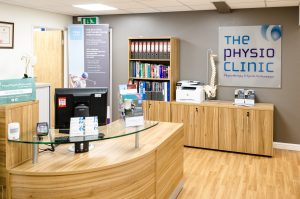 So yes, we are going strong. But sadly, success doesn’t come without a cost and that cost has been my clinical time. Over the last 10 years I’ve built up a large list of clients whom I’ve helped overcome many varied problems, often seeing them on repeated visits for different complaints, not to mention holding many sets of ‘Happy Families’ where I’ve treated several generations of a family. Unfortunately balancing my passion for clinical work and running a successful company has resulted in a reduction in the number of clinics I now run and my availability. I now take this opportunity to say to all my previous clients and future users of the clinic that I am proud to have a team of therapists and support staff who share my values and clinical ethos. A team who I trust to deliver the quality of service that people have grown to expect and a team that I will continue to be a part of, both as clinician and mentor, delivering expert care and overseeing the growth and continued success of The Physio Clinics vision of what Physiotherapy should be. So, rest assured, if I’m not available to assess or treat you, my team has my back and will provide you with the care and service you and others have come to expect, building our success for the future.
So yes, we are going strong. But sadly, success doesn’t come without a cost and that cost has been my clinical time. Over the last 10 years I’ve built up a large list of clients whom I’ve helped overcome many varied problems, often seeing them on repeated visits for different complaints, not to mention holding many sets of ‘Happy Families’ where I’ve treated several generations of a family. Unfortunately balancing my passion for clinical work and running a successful company has resulted in a reduction in the number of clinics I now run and my availability. I now take this opportunity to say to all my previous clients and future users of the clinic that I am proud to have a team of therapists and support staff who share my values and clinical ethos. A team who I trust to deliver the quality of service that people have grown to expect and a team that I will continue to be a part of, both as clinician and mentor, delivering expert care and overseeing the growth and continued success of The Physio Clinics vision of what Physiotherapy should be. So, rest assured, if I’m not available to assess or treat you, my team has my back and will provide you with the care and service you and others have come to expect, building our success for the future.
My road to becoming a runner – Pete Tang
/in Uncategorised/by Pete TangSo, at the end of August in 2016 after a particularly energetic day at the beach the whole family walked the half mile back from the beach, up the sand dunes and the short hill to the cottage we were renting. It’s safe to say that my son and I were clearly out of puff when I heard the fateful words from my wife, Tracy, “You and Alex should do a couch to 5K”. Well I’ve never heard my kids laugh so hard in all my life. “Dad run. Don’t be ridiculous”. My son didn’t seem too concerned.
To put this in to context, those who know me well know ‘I don’t do running’! Now don’t get me wrong, I’ve ran in the past, but that was always for sport, rugby etc or sprints (at School) but distance running…. that’s what you had to do as punishment for dropping the ball.
Like lots of people in their 40’s I’ve done my fair share of intermittent bouts of exercise over the years, gyms, hill walking, mountain biking and for the last few years’ road cycling. I’ve even tried running in the past but always failed for various reasons hence why I don’t do running! My wife however got back into running at the beginning of the year having not ran for 20 years and had truly caught the running bug thanks to North Bristol Running Group.
It was certainly true that the cycling I was doing was helping my health but it was difficult to fit it in all the time and clearly it wasn’t giving me all the fitness benefits I thought it was. My weight wasn’t changing much, I could cycle for miles without too much trouble but I guess I wasn’t challenging myself enough and I was just enjoying the ride. So, after a night’s sleep, a £2.99 app download and with the mocking laughter of my kids still ringing in my ears I decided to take on the challenge and prove them wrong! My son and I will run…..much to his disappointment.
Tracy wasn’t going to let me off once I’d committed so as soon as we returned to Bristol off we went to get trainers. We went to up and running in Henleaze who had fitted Tracy out earlier in the year and offered a fantastic service. Fully kitted out with trainers and an app to guide us my son and I embarked on our first run together.
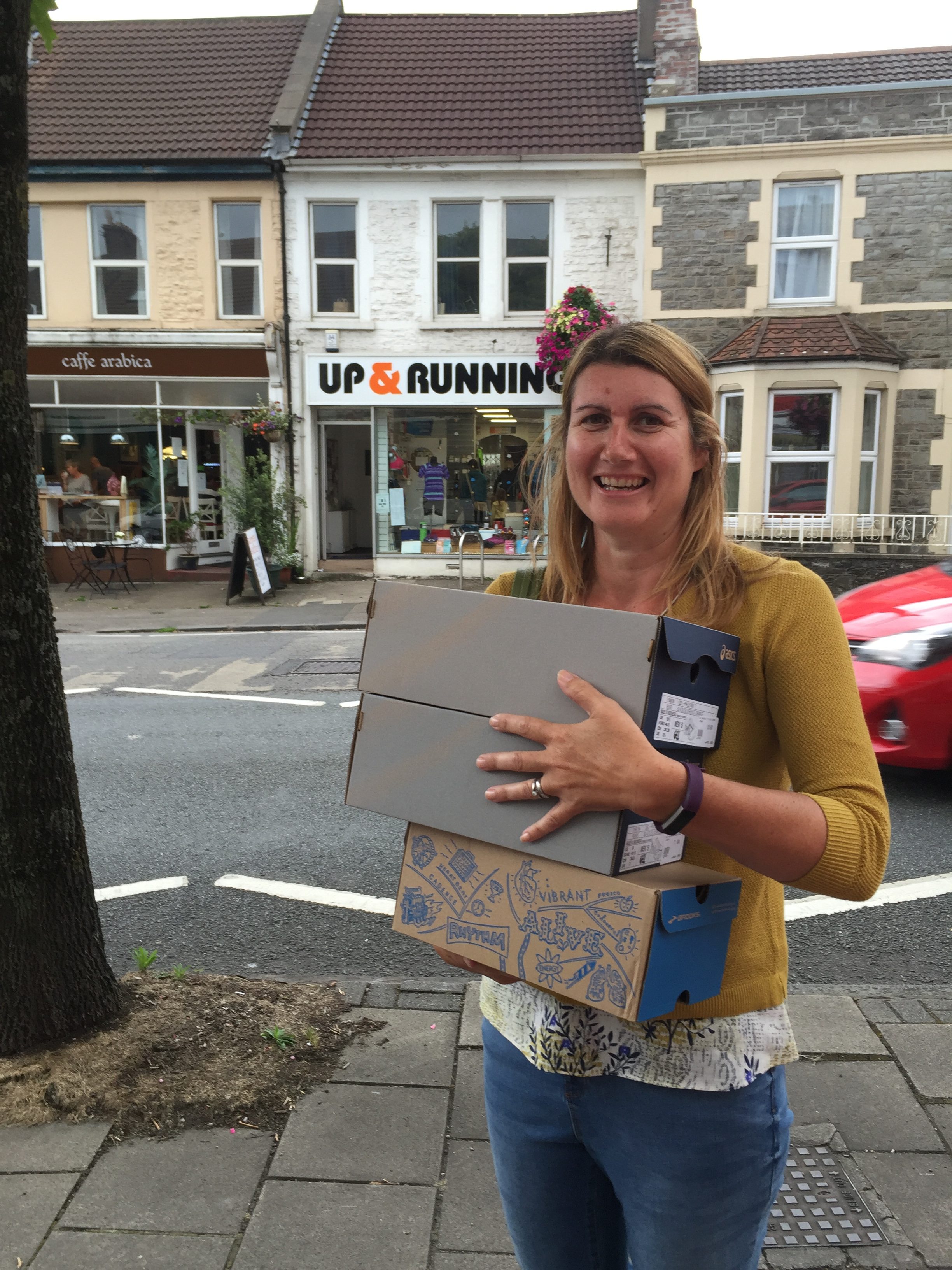
I’ve always struggled in the past to run. Invariably I’d set off too quick end up out of breath or straining something. The Couch to 5K app however made us walk for the first 5 minutes followed by 1 minute of running and then 1.5 minutes walking. We repeated this 1 min run and 1.5 min walk six times and finished our first session as we’d started with a 5 min walk – a grand total of 25 minutes and 1.4 miles; according to Strava. Things increased slowly over the first few weeks, running/walking 3 times a week never more than 30 minutes and with gradually increasing run segments and shorter walking periods.
By week 4 I’d actually managed to walk/run a full 5K by adding a bit extra on to the apps suggested plan. By week 6 however I was starting to get a few niggles especially in the shins and calf plus my old ACL injured knee was playing up, all this despite my dedication to cooling down, using my foam roller and stretching. As a physiotherapist, you can’t always treat yourself and its difficult sometimes to assess your own body and be objective. It was therefore time to pull rank and pull in some favours!
Look out for the next part when I discovered what was causing my knee pain and how I’ve discovered why I keep getting tightness, niggles and strains in my calf and how I’m now managing this.
Optimising Mobility for Runners
/in Uncategorised/by Pete TangThe aim of optimising mobility for runners is so you can run freely, easily and without pain. The role of a Sports Massage Therapist is to help runners down this road (excuse the pun!), by treating the area of pain with soft tissue massage, and to help increase mobility in restricted joints through manual manipulation and exercises that the runner can do at home. This helps to increase the recovery time as well as decrease the chance of injury reoccurrence.
The main joints for runners that we look at are the big 3:
1. Toe: Big Toe Extension (movement required for standing on tip toe)
2. Ankle: Dorsiflexion (movement required for heel walking)
3. Hip: Hip extension (movement required for extending leg behind you)
Big toe extension is important for the toe off stage of gait (the manner in which you walk/ run) which provides the stability for this movement. If your big toe lacks the flexibility needed, then there will be compensation movement further up the chain, for example in your foot, knee or hip, which may then cause pain or injury in this area.
Mobility tip: Place a massage ball (if you don’t have access to this then a cricket ball can be used) under your foot whilst you are sitting in a chair. Roll the ball around until you find a point of pain and then hold the ball in this position whist extending and flexing your toe. Carry this out for a couple of minutes a few times a day.
If there is lack of mobility in the ankle, and therefore a decreased range of motion into Dorsiflexion, this can cause compensatory movements including internal rotation of the foot, or femur.
Mobility tip: Place a resistance band over the top of your foot at the base of your tibia, and with your other foot behind you, stand on the rest of the resistance band. Now lunge forward. Repeat for a couple of minutes on each leg a few times a week.
The amount of hip extension needed for running is rarely, if ever, needed for any other movement in life, so limited mobility into hip extension is a fairly common issue with runners. This can result in compensatory patterns in the lumbar spine, causing lower back pain, or other muscles groups having to work harder such as the quads and calves.
Mobility tip: Go into a kneeling position and place one foot on a wall/ sturdy surface behind you so that your toes are pointing up, and then place your other foot in front of you with your foot in front of your knee. Ensure you have a neutral spine whilst in this position. Place your hands by your front foot, in a sprint position. Move your hips forward to feel a stretch up the front of your leg going into your hip flexors. Hold this stretch for 30 seconds on each side and repeat 3 times. By releasing the front of the leg will increase hip extension.
These are just a few examples of the importance of mobility, and tips on how to increase your mobility.
If you would like to find out more and be tested/ treated get in touch with The Physio Clinic today to book your Sports Massage Appointment.
https://www.thephysioclinicbristol.co.uk/sports-massage/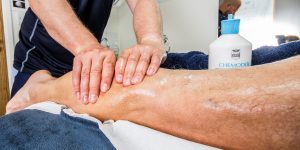
By Kate Griffiths
Get in Contact
We understand that people often don't know what we do or how we can help. Don't worry we're here to help.
To ask us a question or to book an initial appointment simply call 01454 54 00 66 for our Bristol Clinic or 01291 76 99 66 for our Chepstow Clinic and one of our friendly team will assist you with your enquiry.
Alternatively, please fill in the form on the Contact page.
Search the Website
Testimonials
"This was the first time visiting a sports massage, needed due to an injury to my calf. After just 1 session the improvements made have been incredible, and I am already booking more sessions in immediately. Matt Williams, who looked after me, was very friendly and extremely Knowledgeable..."
- Matt Lansdown

